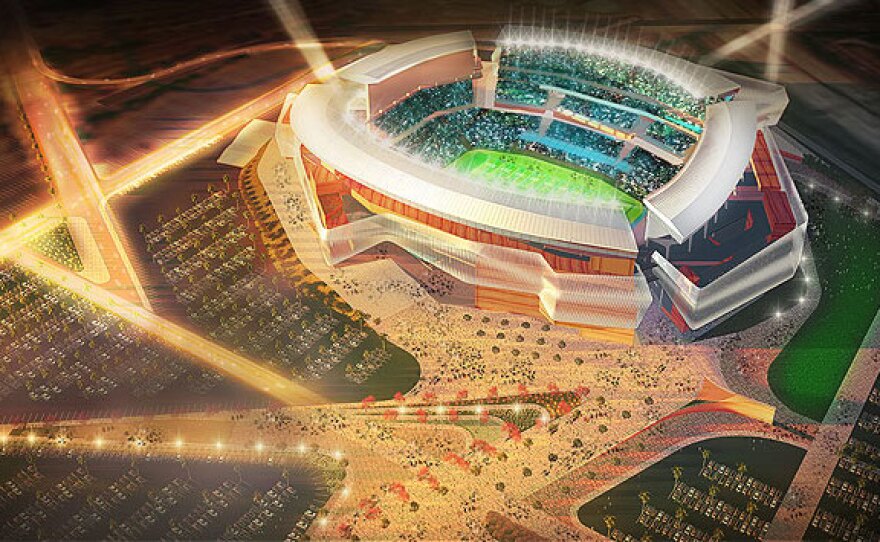The city and county of San Diego would pay $350 million combined under a financing proposal unveiled Monday for a new football stadium in Mission Valley, or about one-third of the total construction cost.
The financing mechanism came on a busy day in which a 6,000-page environmental impact report was released by the office of Mayor Kevin Faulconer, renderings of a design concept were put on display, and a city/county negotiating team met with a group of National Football League owners in Chicago.
The efforts are being undertaken to try to keep the Chargers in San Diego — nearly 15 years after the local NFL franchise began asking for a replacement for aging Qualcomm Stadium. The team has purchased land in Carson, in Los Angeles County, to build its own stadium if no deal is struck to stay in its current city.
Returning a team to Los Angeles for the first time since the 1994 season is a major NFL priority.
Faulconer told reporters that the city is "on the hook for hundreds of millions of dollars" under its current financial arrangement with the team and to operate the stadium in the future. A city report issued last week estimated it would cost $282 million over the next 20 years to operate the facility.
"We can fix that with a financial deal that's better for the taxpayers," Faulconer said. "It's no secret that our current financial agreement with Qualcomm Stadium leaves much to be desired."
The financing proposal calls for the Chargers to contribute $362.5 million and the NFL $200 million, and for $187.5 million in personal seat licenses to be sold, with the county contributing its share in cash and the city taking out bonds.
"The financing concept is comprised of four main elements — no new taxes on San Diegans, two dollars of private money for every dollar in public funds, and it will require voter approval," Faulconer said. "And it protects taxpayers — it caps the public contribution to the new stadium, and makes the Chargers responsible for operating and maintaining the stadium, and it ensures that taxpayers are not on the hook for cost overruns."
Taxpayer protection is missing in the current deal with the Chargers, he said.
The financing proposal differs from one issued in May by a mayoral task force in that it does not rely on income from other development on the site, like shops and office buildings — something that will be dealt with separately and later.
Faulconer, county Supervisor Ron Roberts and City Attorney Jan Goldsmith urged the Chargers to return to the negotiating table and agree to the plan so that it can go before voters in January.
The environmental impact report is now available for public comment, and will likely be tweaked in the coming weeks by city staff, according to Goldsmith. The document needs to be approved by the City Council in October in order for the deal to go to voters by Jan. 12.
Opposition by the Chargers to the speed in which the study was performed led the team to break off talks with city and county officials in June. Asked to comment on the day's events, team special counsel Mark Fabiani focused on the EIR.
"Never before in California history has a controversial, billion-dollar project relied on environmental review documents hastily prepared in three weeks," Fabiani said.
"The Chargers have been clear from the start that the franchise will not be the city's guinea pig for this inevitably ill-fated legal experiment," Fabiani said. "Remember, these are the same politicians who told us, with disastrous results in court, that the convention center expansion could be financed by a vote of the hoteliers rather than a vote of the people."
The convention center project's financing mechanism, developed under ex- Mayor Jerry Sanders, was struck down in court.
City officials maintain that the EIR will hold up to scrutiny because the project is merely replacing one stadium with a similar, and smaller, facility, so the impacts are already largely known.
Color renderings by the firm Populous depict various areas of the stadium, including the bowl and outside plazas. The drawings also show where on the 166-acre Mission Valley site the new stadium would be located.
"This conceptual design was inspired by San Diego's iconic sights and our breathtaking beauty — showcasing our region in a new and exciting way," Faulconer said.
"It shows a multi-purpose sports stadium that would be capable of hosting professional sports, including, of course, NFL games, San Diego State Aztec games, soccer, and of course our two bowl games — the Poinsettia Bowl and the Holiday Bowl, as well as entertainment, cultural and commercial events," Faulconer said.
Stephen Puetz, Faulconer's chief of staff, said a negotiating team representing San Diego met with six NFL team owners overseeing the process of returning a franchise to the Los Angeles area.
















